Solar Panel Cleaning Systems and their Pros and Cons
Carla Dawson
August 30, 2022This article is dedicated to solar panel cleaning systems used in the commercial, industrial, and utility-scale segments.
- Wet Cleaning Systems
- Water Fed Pole (Automatic or manual) – Rotary Brush
- Solar Panel Cleaning Robotics
- Lift & Shift (Automatic or manual)
- Tractor Brush
- Bridge (Innovation in progress)
- Dry Cleaning Machinery
- Lift and Shift (manual & Semi-automation)
- Tractor Brush (Semi-automation)
- Solar Panel Cleaning Robotics (Semi-Automation)
- Rumba (100% Automation)
- Fixed Slider with Docking Station (100% automation)
- Multiple Innovations in Progress
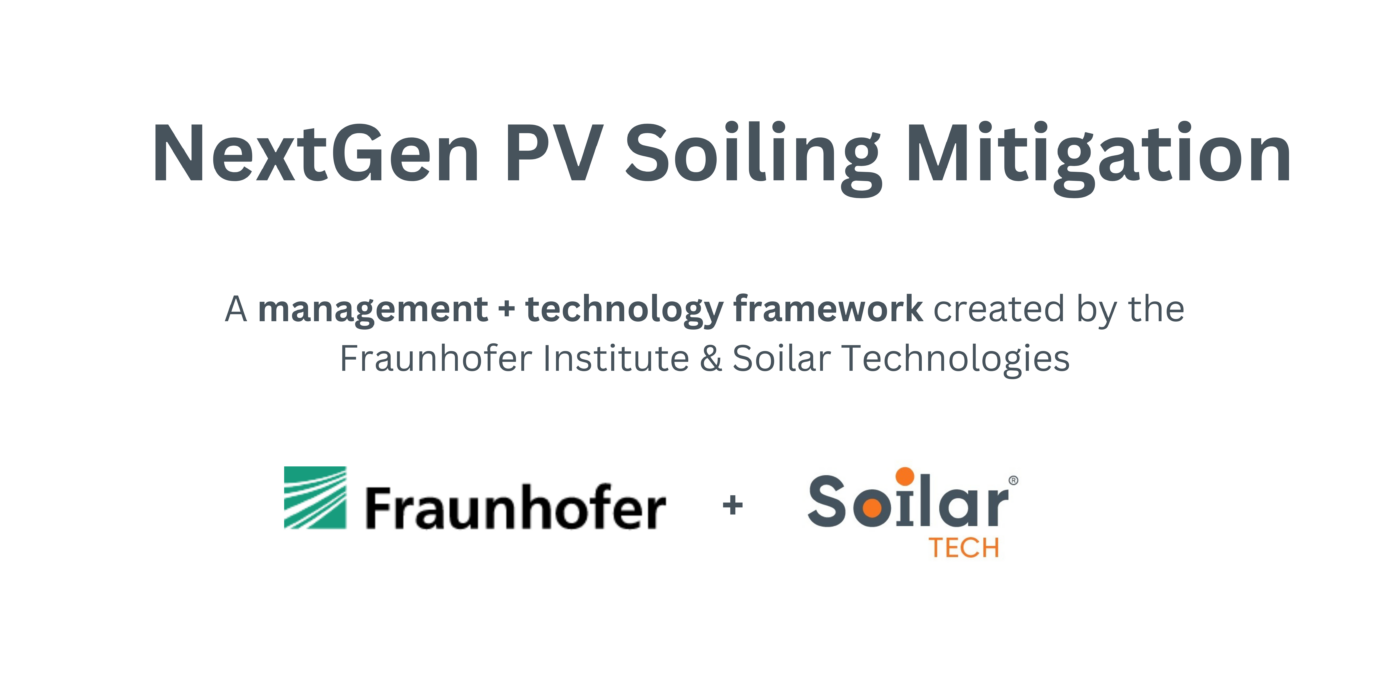
Solar Panel Cleaning System Framework
The following post is dedicated to solar panel cleaning systems for the commercial, industrial and utility-scale solar panel cleaning segment. While productivity rates are a very important KPI to define your solar panel cleaning system, we recommend considering other variables as well. Below you will find our framework for defining the best solar panel cleaning system for your portfolio of assets that need cleaning.
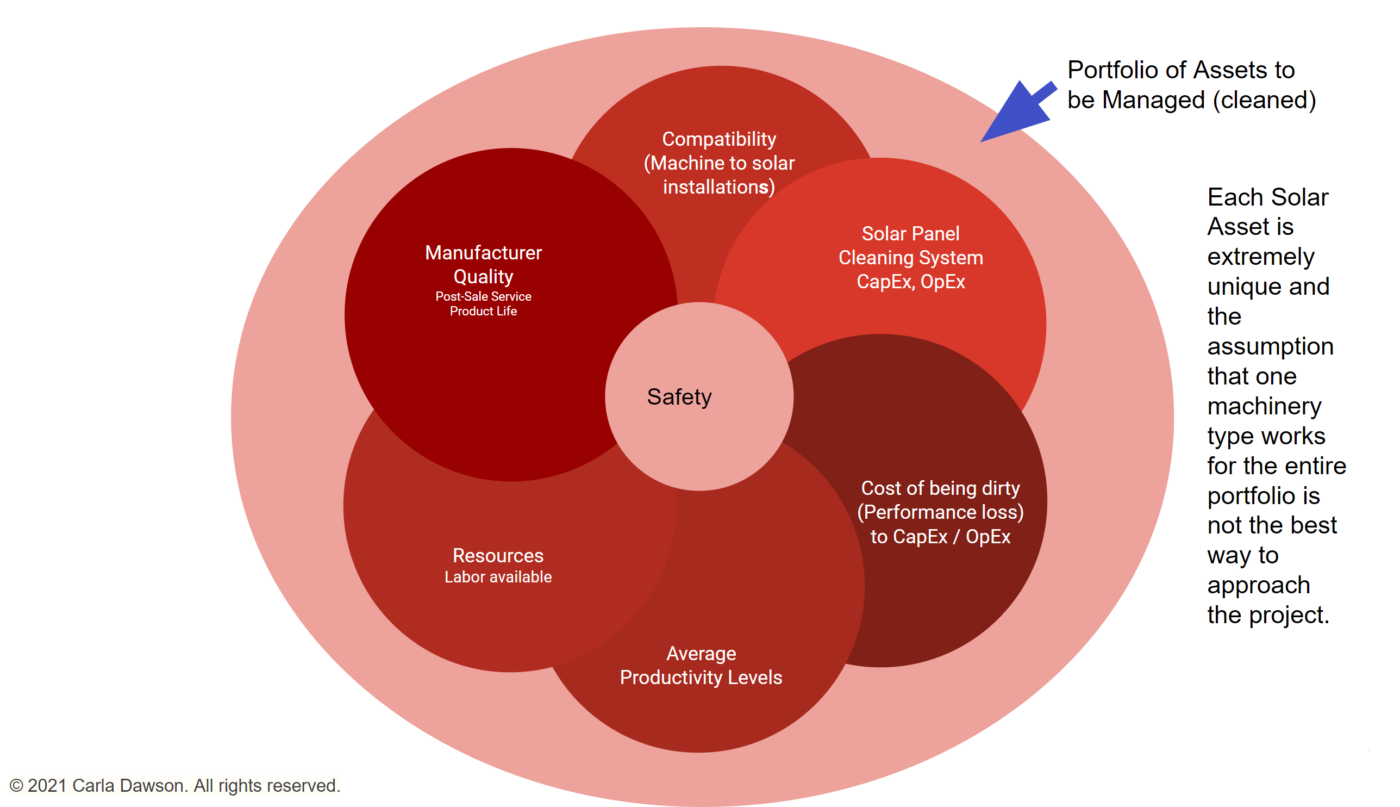
Compatibility (Machine to solar installation)
Solar installations are very diverse and that is their nature. It is fundamental that you choose solar panel cleaning machinery/robotics that is compatible with the solar installations you have to clean. For example, you cannot use a tractor/brush system on an agrivoltaic installation that has crops on the ground. To make a good decision, it is important to understand the solar installation types and the machinery available. If you would like to learn more, you can enroll in our Solar panel & PV Surface cleaning school.
The Economic Value of Solar Panel Cleaning and the Opportunity
Solar panel cleaning is done primarily for economic reasons. Solar farms lose power output and hence revenue. What are the challenges we face in the Solar O&M Industry?
- Quantifying the revenue loss due to soiling
- Quantifying the ideal cleaning frequency and schedule
- Quantify the value add from solar panel cleaning
- Defining the solar panel cleaning equipment that allows for maximum efficiency for the existing PV design
- Altering the PV design to allow for
- Efficiency
- Operator Safety
- Identification of key difficulties in cleaning the solar installation
- Opportunity identification
Case Study = 50 MW at $45/MWh
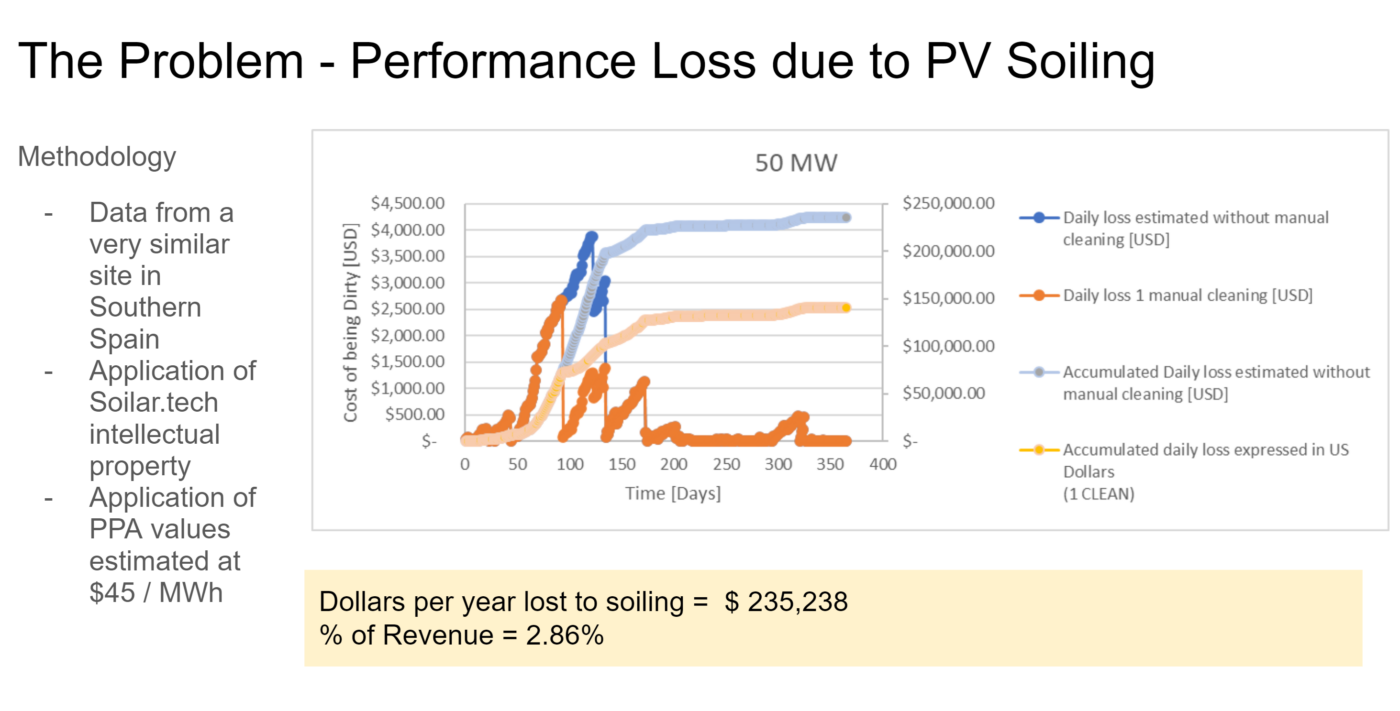
Cleaning frequency if ofter determined by visual inspection but to accomplish an economic impact, it is necessary to work with solutions like our PV soiling monitor and software.
The Opportunity
If managed properly, solar panel cleaning does bring significant economic value. However solar panel cleaning goes hand in hand with the opportunity to apply PV anti-reflective coatings. For more information, please feel free to schedule a meeting here. https://calendly.com/soilar-tech/ In general, PV anti-reflective coatings increase performance 2-4% however knowing when this should be done is the key to accomplishing this economic opportunity. Below you can see that just 2 applications of PV anti-reflective coatings on a 50 MW site create $1,431,820 gains throughout the solar assets lifetime or an ROI of 294% in 7 years or approximately 42% per year. Since these coatings should be applied immediately after cleaning, it is a service offering that can and should be provided by a solar panel cleaning company. If you are interested in learning more about adding solar maintenance service, please contact us at Soilar Technologies. Below you can see the added value of both services on a 50 MW installation.
Solar Panel Cleaning Machinery

Solar Panel Cleaning Systems
There are many ways to clean solar panels but the general dos and don’ts include
- Don’t use a pressure washer
- Don’t use lots of water (it is expensive and the property owner will not forgive you)
- Do consider automation as it lowers the cost of cleaning significantly and increases your productivity and quality
- Understand that there are 2 main segments. 1) Commercial & Industrial Solar Panel Cleaning Systems 2) Utility-Scale Solar Panel Cleaning Systems.
Commercial & Industrial Solar panel cleaning systems
Commercial and Industrial Solar panel cleaning systems are challenging because they rarely have water and energy sources next to the solar panels. They can be dangerous to clean since they may be on rooftops, carports, or off the ground. Each installation is very unique since solar panel installers do not consider cleaning when they design the layout. Soilar Technologies offers this support to PV developers and designers.
The main systems include
Semi-Automation
Within semi-automation, you have solar panel cleaning systems
- Solar Panel Cleaning Robot – The robot is driven by an operator via remote control. The robot travels in xy-axis coordinates and is very similar to driving a remote control toy car. This system requires a high upfront cost but productivity levels improve by 4x. There are several xy semi-automated robots on the market but not all brands are the same and the quality of the manufacturer and post-sale service is important.
- Pros – Productivity rates improve by 4x, Less exposure to employee lawsuits, it safer than cleaning manually, less water consumption, Facilitates scaling of your business. Payback happens within the first month.
- Cons – Requires an investment of USD $20,000 – USD $50,000, Operators must be trained, the robots can be heavy and may require 2 to 3 operators. Inclination levels may be an issue.
- Lift and Shift Solar panel cleaning machine that is moved and allocated by an operator. This system also works nicely but usually requires “Custom-made solar panel cleaning robots”.
- Pros – If inclination levels are high this robot will work, easy to use, and Payback happens within the 6 months
- Cons – Time to delivery, since these robots are custom, you will have to wait 3 months to get them.
Manual Solar Panel Cleaning Systems
- Cleaning manually with a water-fed pole. While this system “works” for just about any installation, it is expensive in terms of labor rates and liabilities associated.
- Pros – cheap labor can be used, easy to start a business with this method
- Cons – Lots of people means lots of liability. Accident levels will be higher with this cleaning system. Water consumption rates are much higher with this system.
Utility Scale Solar Panel Cleaning Systems
- Tractor Brush System – This solution requires a higher upfront cost since you need a tractor, hydraulic arm, and smart rotating brush with proximity sensors however it is the most productive solution on the market.
- Pros – The cheapest way to clean a utility-scale installation, Great payback, and ROI
- Cons – Cannot be used on all installations, may not be ideal for very desertic areas such as the Sahara or Atacama desert
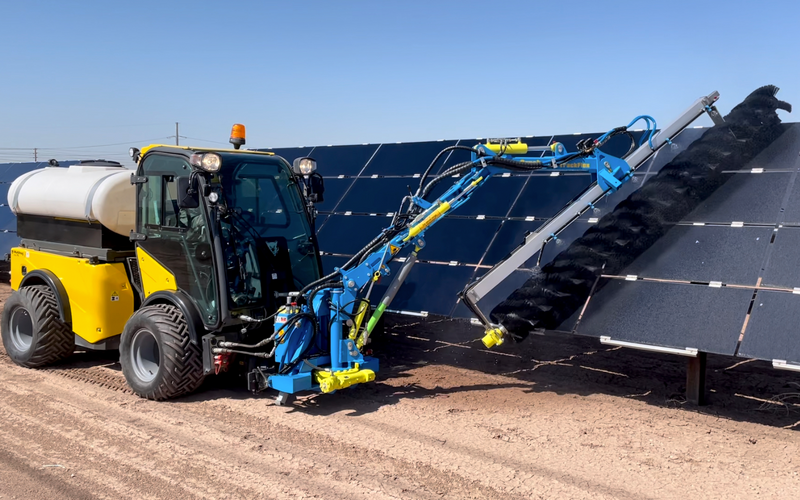
- Powered Lift and Shift – This solar panel cleaning system is great for utility-scale installations where a tractor cannot be used or the ground is pure sand like in the Sahara or Atacama desert. With this solution, the operators fix the robot to several arrays and simultaneously move them down the array. The robots can do dry and wet cleaning and are extremely productive.
- Pros – This system works on just about every utility-scale installation, Payback compared to manually cleaning is extremely high, CAPEX values are reasonable any ROI usually happens with the first cleaning
- Cons – More expensive than the Lift and Shift system, requires more operators than the Tractor Brush system
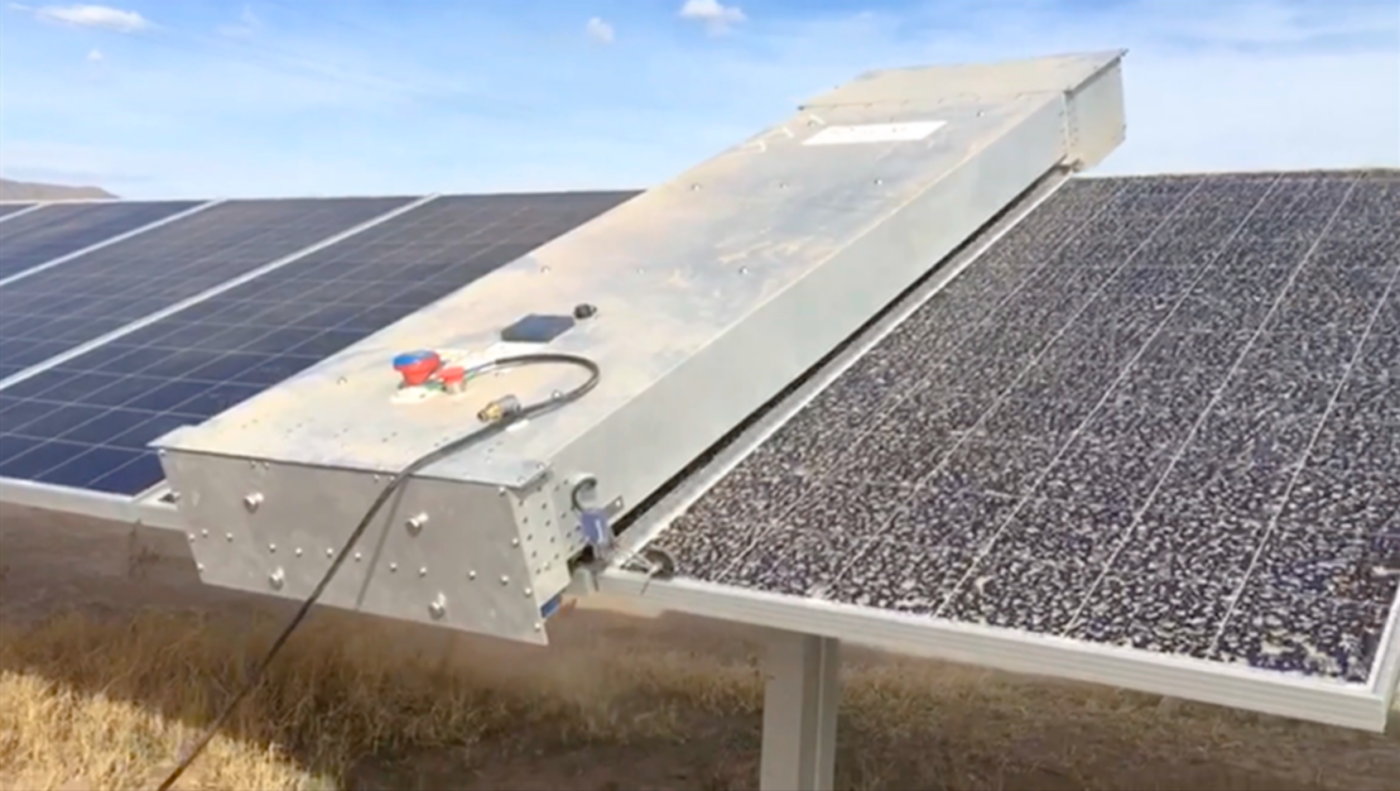
Fixed Slider with Docking Station – 100% Dry cleaning
Dry Solar Panel Cleaning Robotics
- – – This system is abuzz these days and conceptually it is very simple. We have one robot per row/array that is fixed and solar-powered. The robot moves back and forth daily and no human intervention is needed. While this system is being implemented the CAPEX values are extremely high and the performance loss due to soiling “the cost of being dirty” on the solar panels has yet to prove that the ROI is ideal.
- Pros – Human intervention is only required for technical repair. Performance loss due to solar panel soiling is virtually zero. Great for areas that are VERY remote and with extremely high soiling levels.
- Cons – CAPEX values are VERY high and performance loss due to soiling has to average over 3% for this system to be justified. The financials still do not prove that this system is economically beneficial. These solutions only work in extremely arid regions such as the Atacama and Sahara desert where humidity levels are virtually non-existent since they only do dry cleaning. These solutions do not work well where there is humidity.
Solar Panel Cleaning Automation is a very young industry. When choosing your system we recommend you work with consultants to find the best solution for your company or installation. Key takeaways
- Study the system cost not just the cost of the machinery.
- Calculate your CAPEX & OPEX for each system to determine the best solution from a financial perspective.
- Water is expensive, consider it in your analysis. Different robots have different consumption levels.
- Robots have different productivity levels, consider this in your analysis.
- Wear and Tear are extremely important – There are lots of cheap robots on the market that high very high wear and tear costs. Consider this factor in your analysis.
- Inclination levels are a factor you must know. Not all robots have great inclination levels.
- PV Soiling Levels are key. You have to compare the cost of being dirty to the cost of each solar panel cleaning system to see with the system is ideal. Invest in soiling monitoring such as the solutions.
- Work with solar panel cleaning engineers to find the best solution.
The quest to find the most productive machine
Most O&M directors or solar panel cleaners begin their quest for finding the ideal machinery by looking for the most productive machine in the marketplace. This is a very valid beginning however solar panel cleaning has many complexities and setup time and distance between installations is one of the biggest challenges when trying to do the job.
Common Mistakes
1. Asking the manufacturer of the machinery “How many panels per day can the machine do”? Productivity is ideally measured by square footage or similar. This is a direct relationship between brush width and array width.
2. Assuming the answer the manufacturer gives you is truthful.
3. Assuming you can be performing impeccably 24 x 7. The distance between sites often conditions your crew to clean one site per day in the case of C&I installations.
4. Assuming that machinery productivity impacts the project more than logistical efficiency. Experience has shown that logistics are a dominating factor in the success of a project.
5. Distance to project sites is a bigger factor than machine productivity
6. Setup and Logistics are a bigger factor in many situations (not all) than machine productivity
7. Assuming water filtration is done flawlessly and without delays.
8. Assuming your crew is 100% productive
9. Understanding that weather may impact your productivity more than machine productivity. If it is raining, you cannot clean.
10. Assuming that the logistical part of the business is easy
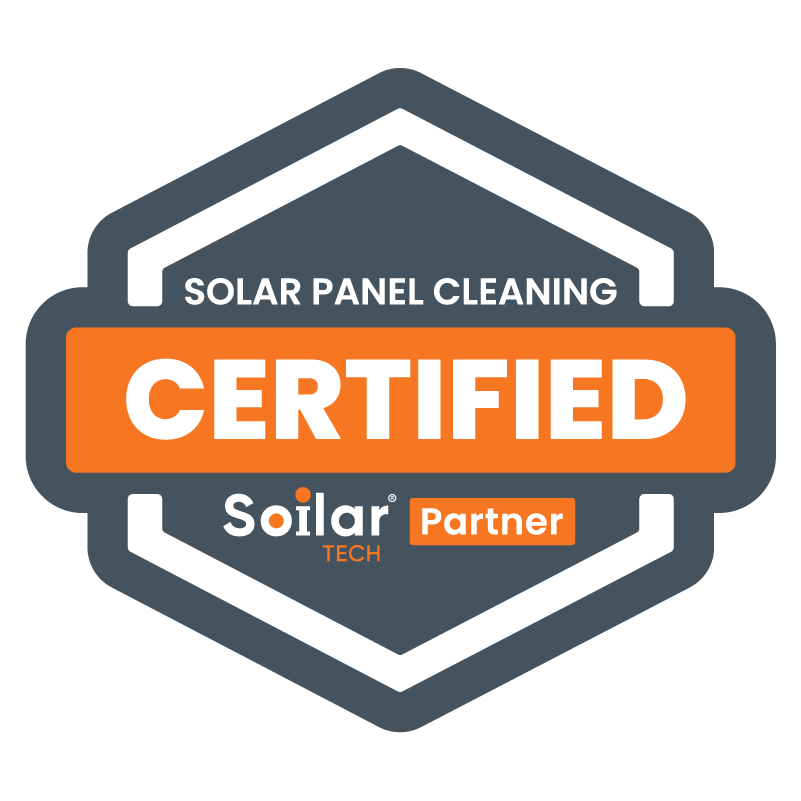
Learn more about our Solar Panel Cleaning Certified Partners here.
Follow us on Instagram, Linkedin, Twitter.
Copyright © 2019 Carla Dawson. All rights reserved.
All documents are protected within the meaning of copyright law.
Carla Dawson reserves all rights to exercise intellectual property rights.
Copying of this content is not permitted without express written authority.
Violations are an offense and are liable for damages.
About the author
Carla Dawson founded Soilar Technologies, a NextGen PV Soiling Mitigation Technology Company in 2019.
NextGen PV soiling mitigation can be defined as:
“Mitigating photovoltaic soiling by using 21st-century technologies throughout the solar plant lifecycle with the objective of increasing performance, reliability, asset life, and warranty compliance. NextGen PV Soiling mitigation is typically a data-enriched smart system that combines technologies such as solar panel cleaning robotics, PV anti-soiling coatings, PV abrasion testing, bird deterrent solutions, PV soil monitoring, electrodynamic shields (EDS), condensation prevention, tracker/stowage position, and cleaning schedule optimization, solar panel cleaning software, analytics and other technologies.”
NextGen PV soiling mitigation is a phrase that was coined by Carla Dawson and Klemens Ilse in 2022.
Soilar Technologies is dedicated to helping solar panel cleaners, EPC, solar installation companies, and entrepreneurs solve their PV soiling problems from design to the operations and maintenance stage.

